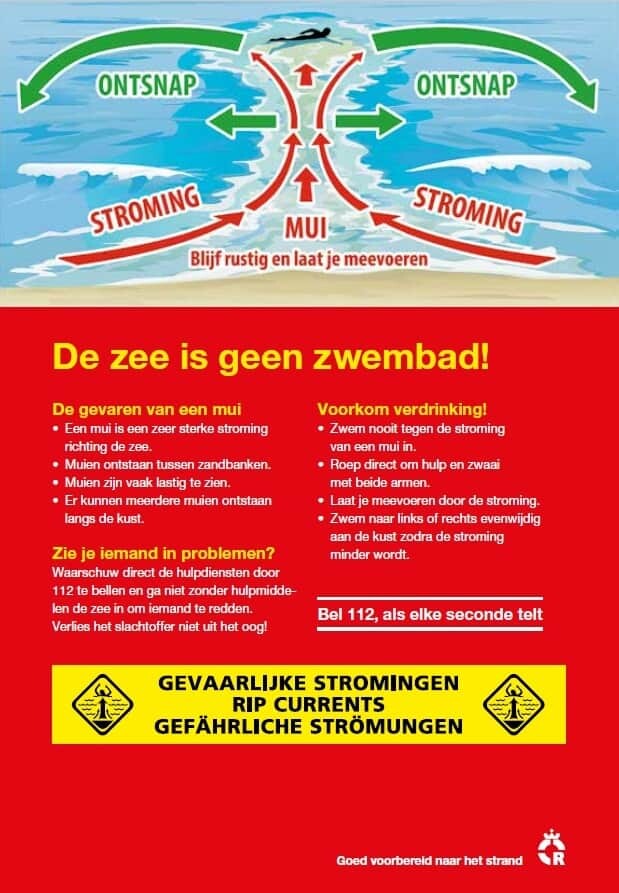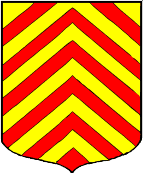Seawater waves over the sandbanks
Seawater undulates across the sandbars toward the shore, but back, the water mostly finds a way between the sandbars. Through the so-called “mussels,” water can flow away at such high speeds that it cannot be swum against. Therefore, those who do unexpectedly find themselves in a mui are advised to swim offshore towards one of the sandbanks, and from there back ashore. If that doesn’t work, try to catch other people’s attention.


Muien
A major danger on Egmond beach are the mussels. A mui is a deeper section across the shoreline between two sandbanks. The water in between the beach and the sandbanks (called swamp) flows toward these deeper areas during rising tide (from low tide to high tide, then it becomes high tide) and sinking tide (from high tide to low tide, then it becomes low tide). This creates a powerful current toward the sea.
This sea current in itself is not dangerous because it weakens further from the shoreline but the ancillary issues are dangerous. These include ignorance, fear, fatigue, (salt) water in eyes/mouth, overestimating yourself and underestimating the power of the sea.
What you can do:
- Make gestures that there is trouble (that way bystanders can get help);
- Go with the flow;
- When the current eases swim slightly parallel to shore;
- Then swim toward the breaking waves (shallow);
- Rest when there is ground underfoot again;
- Continue towards the beach through the swin.
Note that the mui is always present and the location may vary daily. As much as possible, the lifeguards indicate the dangerous points by signage or barriers.
Some other dangers include:
- Dehydration during sunny and hot days.
- Always provide plenty of food and drink (yellow alcohol).
- Digging in the sand. Digging pits is fun, of course, but keep it shallow and watch out for begging.
- Losing sight of each other. Keep a close eye on each other and especially children, on beach you will lose each other in no time.
Always follow the directions of lifeguards.
- Don’t go swimming alone.
- Do not swim under the influence of alcohol or drugs
- Never swim near mussels or breakwaters
- Don’t go swimming with a full stomach
- Make sure you can still stand
- Make it clear to other beachgoers/swimmers if you need help
- Alert lifeguards when someone else needs help
- Do not enter the water overheated, cool off slowly first
- Always follow the directions of lifeguards
Tides and Currents
The sun and moon exert attraction on the water. This causes water to move, both vertically and horizontally (so-called tidal phenomena). These movements create a highest (HW) and a lowest (LW) water level. From the time of LW to the time of HW the water rises (flood), from the time of HW to the time of LW the water falls (ebb). The force of attraction which the sun and moon exert on the earth is not everywhere equal, but depends on the position, which a place on earth occupies at a certain moment in relation to the sun and moon. Differences in attraction are created by the earth’s rotation around its own axis and the earth’s rotation around the sun; as a result, the earth’s water gets into a regularly recurring motion: the tidal movement.
Huge Wave
The tidal movement is best imagined as a huge wave, rolling forward across the earth. When the crest of this wave has reached us, we have high tide; when the valley has reached us, low tide
The duration of a tidal cycle due to the influence of the moon is about 24 hours 50 minutes, the duration of a tidal cycle due to the influence of the sun is 24 hours and is much less strong than that of the moon On the Dutch coast it is 2x a day HW and LW, so the duration of a tidal movement is ca.12 hours 25 minutes.
Sun and moon
Dead Tide
When the tide-generating forces work against each other, a neap tide occurs. This is the situation with the lunar phases first quarter (EK) and last quarter (LK). EK and LK fall approximately seven days after resp. NM and VM. This means, that about seven days after spring tide is a neap tide and seven days later is another spring tide.
When the sun and moon are in each other’s alignment, as it were, with respect to the earth, they join forces and attract more water. This is called spring tide. The level of the water is then higher at high tide and lower at low tide. The moon and sun can also oppose each other. This happens when the two celestial bodies are at right angles to each other. The water is then pulled from two different sides, resulting in a much lower than average rise. This phenomenon is called neap tide.
Spring tide
Spring tides occur twice per lunar month (of 29.53 days). You would expect spring tides to be at full moon and at new moon. However, it turns out to fall two days later.
The lunar orbit is generally at a certain angle to the Earth’s orbit around the Sun. As a result, the sun, earth and moon almost never really align. If it does, a lunar or solar eclipse occurs.
Sun tide
The solar tide, with a period of12 hours, continually overtakes the lunar tide, with a period of12 hours 25 minutes. This causes, that the lunar tide suffers from a swell: it is periodically strengthened and weakened. It also has an effect on the timing of the tide. Between spring tide and neap tide, the solar tide has an advancing effect on the tide, between neap tide and spring tide a retarding effect.









